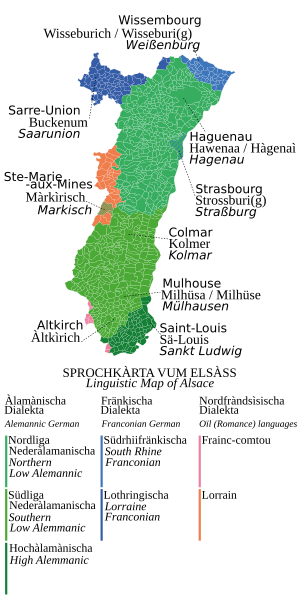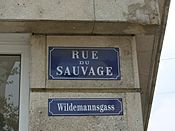Alsatian dialect facts for kids
Quick facts for kids Alsatian |
||||
|---|---|---|---|---|
| Elsässisch, Elsässerditsch | ||||
| Native to | France | |||
| Region | Alsace | |||
| Native speakers | 900,000 (2013)e19 | |||
| Language family |
Indo-European
|
|||
| Official status | ||||
| Recognised minority language in | ||||
| Regulated by | No official regulation Officially promoted through the 'Office pour la Langue et les Cultures d’Alsace et de Moselle (OLCA)' (Office for the language and cultures of Alsace and Moselle), funded by the Grand Est region (formerly the Alsace region), and the departmental councils of Bas-Rhin and Haut-Rhin. |
|||

Linguistic Map of Alsace
|
||||
|
||||
Alsatian (Elsässisch or Elsässerditsch) is a group of Alemannic German dialects. It is spoken in most of Alsace, a region in eastern France. This area has been part of France and Germany at different times in history.
Contents
What is Alsatian?
Alsatian is a language that's part of the Alemannic German family. It's like a cousin to languages such as Swiss German and Swabian. People sometimes confuse it with Lorraine Franconian, another language spoken nearby, but they are different.
Like many languages, Alsatian has borrowed words from other languages. You can find words from Yiddish in Alsatian. Also, modern Alsatian uses words from French and English, especially for new technologies.
Many Alsatian speakers can write in Standard German if needed. However, they usually only do this if they learned German in school or at work. People choose to speak Alsatian depending on where they are and who they are talking to. Some speakers prefer to use French with outsiders instead of Standard German.
If you live near the border with Basel, Switzerland, you might find that Alsatian speakers can easily talk with Swiss people from that area. This is because their dialects are very similar. You might also see street names in Alsace written in both French and Alsatian, especially in cities like Strasbourg and Mulhouse.
Who Speaks Alsatian?
Alsatian in France Today
Since 1992, the French constitution says that French is the official language of the country. However, Alsatian is one of the regional languages recognized by the French government. France has signed an agreement to protect regional languages, but it hasn't fully put it into law.
The French government's policies have made it harder for regional languages like Alsatian to thrive. Because of this, Alsatian, which used to be the main language in Alsace, is now spoken less often. A survey in 1999 found about 548,000 adults in France spoke Alsatian. This made it the second most-spoken regional language after Occitan.
However, fewer young people are learning Alsatian. While 43% of adults in Alsace speak it, its use is going down among younger generations.
Alsatian in the United States
A dialect of Alsatian German is also spoken in the United States. A group called the Swiss Amish, whose ancestors moved there in the mid-1800s, speak it. About 7,000 people speak this dialect, mostly in Allen County, Indiana.
How Alsatian is Written
Alsatian uses letters similar to those in German and French. Here are the letters used:
| Big letters | A | B | C | D | E | F | G | H | I | J | K | L | M | N | O | P | Q | R | S | T | U | V | W | X | Y | Z | Ä | À | Ë | É | È | Ì | Ö | Ü | Ù |
|---|---|---|---|---|---|---|---|---|---|---|---|---|---|---|---|---|---|---|---|---|---|---|---|---|---|---|---|---|---|---|---|---|---|---|---|
| Small letters | a | b | c | d | e | f | g | h | i | j | k | l | m | n | o | p | q | r | s | t | u | v | w | x | y | z | ä | à | ë | é | è | ì | ö | ü | ù |
The letters C, Q, and X are mostly used for words borrowed from other languages. The letter Y is also more common in borrowed words.
Orthal: A Special Way to Write Alsatian
Orthal is a special writing system created to help all Alsatian dialects be written in a similar way. It was developed by the Office for the Language and Cultures of Alsace and Moselle (OLCA).
The main ideas behind Orthal are:
- It follows the rules of Standard German writing for common vowels like A, E, I, O, U, and their special forms like Ä, Ö, Ü.
- For sounds that don't exist in Standard German, Orthal combines letters to create new sounds.
- It uses French accent marks (like ´ and `) to show unique Alsatian vowel sounds.
- It also follows Standard German rules for consonants.
Alsatian Grammar Basics
Alsatian nouns change their form based on their role in a sentence, their gender, and whether they are singular or plural.
- Cases: Alsatian has three cases: nominative, accusative, and dative. Unlike Standard German, Alsatian does not use a genitive case. Instead, it uses the dative case or the word "vu" (meaning "of") with the dative.
- Genders: Nouns can be masculine, feminine, or neuter.
- Numbers: Nouns can be singular (one) or plural (more than one).
Comparing Alsatian Words
Here's how some common words look in Alsatian compared to other languages:
| English | Southern Alsatian (Haut-Rhin) |
Northern Alsatian (Bas-Rhin) |
High Alemannic (Swiss German) |
Standard German | Swabian German | Luxembourgish | Pennsylvania German | Standard French |
|---|---|---|---|---|---|---|---|---|
| house | 's Hüss | s' Hüs | Huus | Haus | Hous | Haus | Haus | maison |
| loud | lütt | lüt | luut | laut | lout | haart | laut | bruyant |
| people | d' Litt | d' Lit | Lüt | Leute | Leid | Leit | Leit | gens/peuple |
| today | hìtt | hit | hüt | heute | heid | haut | heit | aujourd'hui |
| beautiful | scheen | scheen | schö(n) | schön | sche | schéin | schee | beau |
| Earth | d' Arda | d' Erd | Ärd(e) | Erde | Erd | Äerd | Erd | terre |
| Fog | d'r Nawel | de Näwwel | Näbel | Nebel | Nebl | Niwwel | Newwel | brouillard |
| water | 's Wàsser | 's Wàsser | Wasser | Wasser | Wasser | Waasser | Wasser | eau |
| man | d'r Mànn | de Mànn | Maa | Mann | Mà | Mann | Mann | homme |
| to eat | assa | esse | ässe | essen | essa | iessen | esse | manger |
| to drink | trìnka | trinke | trinkche | trinken | trenka | drénken | drinke | boire |
| little | klei | klein/klaan/klëën | chl(e)i | klein | kloi | kleng | glee | petit, petite |
| child | 's Kìnd | 's Kind | Chind | Kind | Kind | Kand | Kind | enfant |
| day | d'r Tàg | de Dàà | Dag | Tag | Dàg | Dag | Daag | jour |
| woman | d' Fràui | d' Frau | Frou/Frau | Frau | Frau | Fra | Fraa | femme |
See Also
 In Spanish: Alsaciano para niños
In Spanish: Alsaciano para niños
- Adolphe Stoeber


